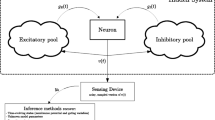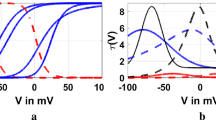Abstract
We discuss methods for optimally inferring the synaptic inputs to an electrotonically compact neuron, given intracellular voltage-clamp or current-clamp recordings from the postsynaptic cell. These methods are based on sequential Monte Carlo techniques (“particle filtering”). We demonstrate, on model data, that these methods can recover the time course of excitatory and inhibitory synaptic inputs accurately on a single trial. Depending on the observation noise level, no averaging over multiple trials may be required. However, excitatory inputs are consistently inferred more accurately than inhibitory inputs at physiological resting potentials, due to the stronger driving force associated with excitatory conductances. Once these synaptic input time courses are recovered, it becomes possible to fit (via tractable convex optimization techniques) models describing the relationship between the sensory stimulus and the observed synaptic input. We develop both parametric and nonparametric expectation–maximization (EM) algorithms that consist of alternating iterations between these synaptic recovery and model estimation steps. We employ a fast, robust convex optimization-based method to effectively initialize the filter; these fast methods may be of independent interest. The proposed methods could be applied to better understand the balance between excitation and inhibition in sensory processing in vivo.









Similar content being viewed by others
Notes
We assume V t is constant, or at least changes slowly enough that we may ignore capacitative effects, though these may potentially be included in the model as well.
This time constant τ i will typically be quite small. Mathematically speaking, it prevents any discontinuous jumps in the observed current, while physically, it may represent the lumped dynamics of the electrode and any non-space-clamped (electrotonically-distant) segments of the neuron.
In the case of Monte Carlo methods for computing the expectations needed in the EM algorithm, as in the particle filter employed here, the likelihood is no longer guaranteed to increase, due to random Monte Carlo error. However, given a sufficient number of samples (particles), the algorithm will still converge properly to a steady state, where the parameters “wobble” randomly around the location of the local likelihood maximum.
In the case of noisy or incomplete observations of the voltage V(t), we need to compute three additional sufficient statistics, \(E(V(t) | \theta^{i-1}, V^{\rm obs}_{0:T})\), \(E(V(t)^2 | \theta^{i-1}, V^{\rm obs}_{0:T})\), and \(E(V_{t-dt} V(t) | \theta^{i-1}, V^{\rm obs}_{0:T})\). These may be similarly estimated from the output of the particle filter, specifically Eq. (9). Finally, as noted in Huys et al. (2006) and Huys and Paninski (2009), it is possible to estimate the additional model parameters, (g l ,V l ,V E ,V I ), via straightforward quadratic programming methods, once the sufficient statistics are in hand. However, if g I and g E have free offset terms it is not possible to uniquely specify the leak parameters, (g l ,V l ), unless observations are made at a wide range of voltages. If only a single voltage is observed, then there are more free parameters than data points and the model is not uniquely identifiable.
It is important to make a note about the errorbars computed here. These are estimates of the posterior standard deviation \(Var(g_t | V^{\rm obs}_{0:T}, \hat \theta)^{1/2}\), where we have conditioned on our estimate of the parameter θ. Clearly, this will be an underestimate of our true posterior uncertainty, which should also incorporate our uncertainty about \(\hat \theta\). It is possible to employ Markov chain Monte Carlo methods to incorporate this additional uncertainty about \(\hat \theta\) (Gelman et al. 2003), but we have not yet pursued this direction.
References
Ahmadian, Y., Packer, A., Yuste, R., & Paninski, L. (2011). Designing optimal stimuli to control neuronal spike timing. Journal of Neurophysiology, 106, 1038–1053.
Anderson, J., Carandini, M., & Ferster, D. (2000). Orientation tuning of input conductance, excitation, and inhibition in cat primary visual cortex. Journal of Neurophysiology, 84(2), 909.
Araya, R., Jiang, J., Eisenthal, K. B., & Yuste, R. (2006). The spine neck filters membrane potentials. PNAS, 103(47), 17961–17966.
Badel, L., Richardson, M., & Gerstner, W. (2005). Dependence of the spike-triggered average voltage on membrane response properties. Neurocomputing, 69, 1062–1065.
Bickel, P., Li, B., & Bengtsson, T. (2008). Sharp failure rates for the bootstrap particle filter in high dimensions. IMS Collections 2008 (Vol. 3, pp. 318–329).
Borg-Graham, L., Monier, C., & Fregnac, Y. (1996). Voltage-clamp measurement of visually-evoked conductances with whole-cell patch recordings in primary visual cortex. Journal of Physiology-Paris, 90(3–4), 185–188.
Boyd, S., & Vandenberghe, L. (2004). Convex optimization. Oxford University Press.
Brette, R., Piwkowska, Z., Rudolph, M., Bal, T., & Destexhe, A. (2007). A nonparametric electrode model for intracellular recording. Neurocomputing, 70, 1597–1601.
Brockwell, A., Rojas, A., & Kass, R. (2004). Recursive Bayesian decoding of motor cortical signals by particle filtering. Journal of Neurophysiology, 91, 1899–1907.
Cafaro, J., & Rieke, F. (2010). Noise correlations improve response fidelity and stimulus encoding. Nature, 468(7326), 964–967.
Casella, G., & Berger, R. (2001). Statistical inference. Duxbury Press.
Cocco, S., Leibler, S., & Monasson, R. (2009). Neuronal couplings between retinal ganglion cells inferred by efficient inverse statistical physics methods. Proceedings of the National Academy of Sciences, 106(33), 14058–14062.
Dempster, A., Laird, N., & Rubin, D. (1977). Maximum likelihood from incomplete data via the EM algorithm. Journal of the Royal Statistical Society, Series B, 39, 1–38.
Dombeck, D., Blanchard-Desce, M., & Webb, W. (2004). Optical recording of action potentials with second-harmonic generation microscopy. The Journal of Neuroscience, 24(4), 999.
Douc, R., Cappe, O., & Moulines, E. (2005). Comparison of resampling schemes for particle filtering. In Proc. 4th int. symp. image and signal processing and analyis.
Doucet, A., De Freitas, N., Murphy, K., & Russell, S. (2000). Rao–Blackwellised particle filtering for dynamic bayesian networks. In Proceedings of the sixteenth conference on uncertainty in artificial intelligence (pp. 176–183). Citeseer.
Doucet, A., De Freitas, N., & Gordon, N. (2001). Sequential Monte Carlo methods in practice. Springer.
Ergun, A., Barbieri, R., Eden, U., Wilson, M., & Brown, E. (2007). Construction of point process adaptive filter algorithms for neural systems using sequential Monte Carlo methods. IEEE Transactions on Biomedical Engineering, 54, 419–428.
Gelman, A., Carlin, J., Stern, H., & Rubin, D. (2003). Bayesian data analysis. CRC Press.
Godsill, S., Doucet, A., & West, M. (2004). Monte Carlo smoothing for non-linear time series. Journal of the American Statistical Association, 99, 156–168.
Green, P., & Silverman, B. (1994). Nonparametric regression and generalized linear models. CRC Press.
Huys, Q., & Paninski, L. (2009). Smoothing of, and parameter estimation from, noisy biophysical recordings. PLOS Computational Biology, 5, e1000379.
Huys, Q., Ahrens, M., & Paninski, L. (2006). Efficient estimation of detailed single-neuron models. Journal of Neurophysiology, 96, 872–890.
Kelly, R., & Lee, T. (2004). Decoding V1 neuronal activity using particle filtering with Volterra kernels. Advances in Neural Information Processing Systems, 15, 1359–1366.
Koch, C. (1999). Biophysics of computation. Oxford University Press.
Kotecha, J. H., & Djuric, P. M. (2003). Gaussian particle filtering. IEEE Transactions on Signal Processing, 51, 2592–2601.
Koyama, S., & Paninski, L. (2010). Efficient computation of the maximum a posteriori path and parameter estimation in integrate-and-fire and more general state-space models. Journal of Computational Neuroscience, 29(1), 89–105.
McCullagh, P., & Nelder, J. (1989). Generalized linear models. London: Chapman and Hall.
Murphy, G. & Rieke, F. (2006). Network variability limits stimulus-evoked spike timing precision in retinal ganglion cells. Neuron, 52, 511–524.
Nuriya, M., Jiang, J., Nemet, B., Eisenthal, K., & Yuste, R. (2006). Imaging membrane potential in dendritic spines. PNAS, 103, 786–790.
Olsen, R. J. (1978). Note on the uniqueness of the maximum likelihood estimator for the tobit model. Econometrica, 46, 1211–1215.
Orme, C. D., & Ruud, P. A. (2002). On the uniqueness of the maximum likelihood estimator. Economics Letters, 75, 209–217.
Paninski, L. (2006a). The most likely voltage path and large deviations approximations for integrate-and-fire neurons. Journal of Computational Neuroscience, 21, 71–87.
Paninski, L. (2006b). The spike-triggered average of the integrate-and-fire cell driven by Gaussian white noise. Neural Computation, 18, 2592–2616.
Paninski, L., Pillow, J., & Lewi, J. (2007). Statistical models for neural encoding, decoding, and optimal stimulus design. In P. Cisek, T. Drew, & J. Kalaska (Eds.), Computational neuroscience: Progress in brain research. Elsevier.
Paninski, L., Ahmadian, Y., Ferreira, D., Koyama, S., Rahnama Rad, K., Vidne, M., et al. (2010). A new look at state-space models for neural data. Journal of Computational Neuroscience, 29(1), 107–126.
Peña, J.-L., & Konishi, M. (2000). Cellular mechanisms for resolving phase ambiguity in the owl’s inferior colliculus. Proceedings of the National Academy of Sciences of the United States of America, 97, 11787–11792.
Pillow, J., Paninski, L., Uzzell, V., Simoncelli, E., & Chichilnisky, E. (2005). Prediction and decoding of retinal ganglion cell responses with a probabilistic spiking model. Journal of Neuroscience, 25, 11003–11013.
Pitt, M., & Shephard, N. (1999). Filtering via simulation: Auxiliary particle filters. Journal of the American Statistical Association, 94(446), 590–599.
Pospischil, M., Piwkowska, Z., Rudolph, M., Bal, T., & Destexhe, A. (2007). Calculating event-triggered average synaptic conductances from the membrane potential. Journal of Neurophysiology, 97, 2544–2552.
Press, W., Teukolsky, S., Vetterling, W., & Flannery, B. (1992). Numerical recipes in C. Cambridge University Press.
Priebe, N., & Ferster, D. (2005). Direction selectivity of excitation and inhibition in simple cells of the cat primary visual cortex. Neuron, 45, 133–145.
Rabiner, L. (1989). A tutorial on hidden Markov models and selected applications in speech recognition. Proceedings of the IEEE, 77, 257–286.
Richardson, M. J. E., & Gerstner, W. (2005). Synaptic shot noise and conductance fluctuations affect the membrane voltage with equal significance. Neural Computation, 17(4), 923–947.
Sawtell, N. (2010). Multimodal integration in granule cells as a basis for associative plasticity and sensory prediction in a cerebellum-like circuit. Neuron, 66(4), 573–584.
Simoncelli, E., Paninski, L., Pillow, J., & Schwartz, O. (2004). Characterization of neural responses with stochastic stimuli. In The cognitive neurosciences (3rd ed.). MIT Press.
Vogelstein, J., Watson, B., Packer, A., Jedynak, B., Yuste, R., & Paninski, L. (2009). Model-based optimal inference of spike times and calcium dynamics given noisy and intermittent calcium-fluorescence imaging. Biophysical Journal, 97, 636–655.
Vogelstein, J., Packer, A., Machado, T., Sippy, T., Babadi, B., Yuste, R., et al. (2010). Fast nonnegative deconvolution for spike train inference from population calcium imaging. Journal of Neurophysiology, 104(6), 3691.
Wang, X., Wei, Y., Vaingankar, V., Wang, Q., Koepsell, K., Sommer, F., et al. (2007). Feedforward excitation and inhibition evoke dual modes of firing in the cat’s visual thalamus during naturalistic viewing. Neuron, 55, 465–478.
Wehr, M., & Zador, A. (2003). Balanced inhibition underlies tuning and sharpens spike timing in auditory cortex. Nature, 426, 442–446.
Xie, R., Gittelman, J., Pollak, G. (2007). Rethinking tuning: In vivo whole-cell recordings of the inferior colliculus in awake bats. The Journal of Neuroscience, 27(35), 9469.
Acknowledgements
LP is supported by an NSF CAREER award, a McKnight Scholar award, and an Alfred P. Sloan Research Fellowship. We thank Y. Ahmadian, Q. Huys, J. Vogelstein, and P. Jercog for many helpful discussions and critical comments. We would like to thank N.B. Sawtell for providing us with the electric fish recordings. A simplified version of the fast optimization-based filter discussed in Section 2.5 was described briefly in the review article (Paninski et al. 2010).
Author information
Authors and Affiliations
Corresponding author
Additional information
Action Editor: Alain Destexhe
Rights and permissions
About this article
Cite this article
Paninski, L., Vidne, M., DePasquale, B. et al. Inferring synaptic inputs given a noisy voltage trace via sequential Monte Carlo methods. J Comput Neurosci 33, 1–19 (2012). https://doi.org/10.1007/s10827-011-0371-7
Received:
Revised:
Accepted:
Published:
Issue Date:
DOI: https://doi.org/10.1007/s10827-011-0371-7




